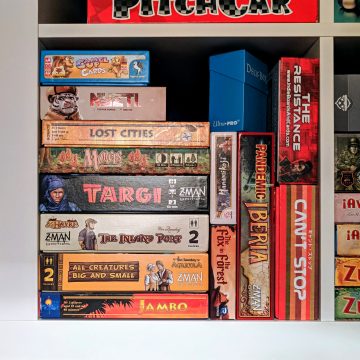It began as a small collection. Bit by bit, it became obvious that one can only dip their toes into the board game hobby for so long. Eventually you took the plunge: an investment in dedicated board game shelving. No more stashing games in the closet and under the bed! You now bear the mark of a true gamer: an entire wall covered in board games. But how did we get here?
 STAGE 1: They Belong in a Museum!
STAGE 1: They Belong in a Museum!
Games are arranged with the care of a curator, and your personal organizational style flourishes. Maybe games are sorted by publisher or theme, or even more whimsical categories such as box color. Most importantly, each shelf has enough space to let the games breathe, with the occasional box even facing forward to show of its beautiful cover. But after reviewing that first shelfie, it looks like that one shelf over there could fit another game…
Look upon my works! The perfect collection of two-player games nestled in this IKEA cube
 STAGE 2: If the Box Fits
STAGE 2: If the Box Fits
Box size trumps all. Organizational preferences are shattered, and similar box sizes are forced together. As smaller games arrive, they are added to the top of the smallest available stack. You won’t let it get too crowded, but short stacks seem so inefficient, and there are just too many good games coming out these days. Golden age, am I right?
OK, so these break the two-player theme of the cube, but it’d be silly to stack these tiny boxes atop Ticket to Ride. This is a much better home for them.
 STAGE 3: Squeezing the Margins
STAGE 3: Squeezing the Margins
That nice slice of vertical real estate once allowed for easy removal of games. You could fit an entire hand in there! But the collection is growing, and any given game doesn’t get played that often. Besides, that space could fit an entire full-sized game.
The virus is spreading
 STAGE 4: Bottoms Up
STAGE 4: Bottoms Up
That box art is oh-so-beautiful, but thankfully, the game’s name is still printed on the bottom. Suddenly, Pandemic looks not much bigger than a Kosmos two-player game. This is fine!
OK, so maybe we lost the player count and game length in some cases, but the names really say it all, don’t they?
 STAGE 5: Cardboard Casualties
STAGE 5: Cardboard Casualties
When every inch of space is almost filled, it’s time for outside-the-box thinking. Did you know you can fit the entire game of Splendor into two small deckboxes?
The most dedicated board gamers have been known to eschew the deck box in favor of an exacto knife, trimming boxes down to a smaller footprint
 STAGE 6: Layers
STAGE 6: Layers
Shelves have now been organized into strata, with most recently-played games prominently displayed, and others pushed back into hidden layers of shame. You haven’t seen Alien Frontiers since 2012, but that’s OK, it’ll just take a minute to dig it out of storage…
Ha! Ha! Just like my shelves! I keep rearranging…do I want them by theme, payer count, or game type? Vehicle or horizontal?
Right now a mixture of both. Solo play and 2 player are separate and then by theme. Yes some games are hidden behind others in my deep IKEA shelving!
Wow I wish I could fix my autocorrect errors! Ugh! My excitement in the topic is showing 😀
Haha, we are the same way. Hard not to get excited when talking about board games!
Step 7: Move
Move to a larger home, start again at step 1
Stage 7: Sell em off! Tired of having unplayed games and no more shelf space, the collector then brings the games to local conventions and sells games, or puts them online for sales and auctions. This allows those earlier in the cycle to accelerate their own processes!
Stage 8: Ignorance is Bliss. After years of trying to keep up with the cult of the new, the collector realizes that so many of the games they have bought just aren’t meeting their expectations. So, they get disillusioned with Kickstarter, Essen and Gencon feeds, and work on a new policy of trying games before buying them.
Sometimes they succeed, but they still end up buying a few without trying them; most of these end up going into the Sale Bag for the next convention.
Stage 9: I don’t know what this yet, as I’m at Stage 8.
I just stopped collecting. I have my favourites. To much disappointment in new stuff. Like readers becoming writers. Designing now, and of course always doing artwork.